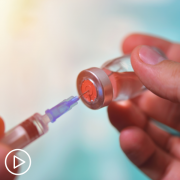Understanding Your DLBCL Treatment Goals
Understanding Your DLBCL Treatment Goals from Patient Empowerment Network on Vimeo.
What are the goals of DLBCL treatment? Expert Dr. Jason Westin explains how treatment goals and timing are established.
Dr. Jason Westin is the Director of Lymphoma Clinical Research in the Department of Lymphoma/Myeloma in the Division of Cancer Medicine at The University of Texas MD Anderson Cancer Center. Learn more about Dr. Westin, here.
See More From The Pro-Active DLBCL Patient Toolkit
Related Programs:

|

|

|
Transcript:
Katherine:
Before we move on to discuss the types of treatment, what are the goals of DLBCL treatment and how do they vary by patient.
Dr. Westin:
It’s a very important question to define at the outset what are we trying to accomplish when we’re talking about different treatments that we could recommend. DLBCL is a curable disease but, unfortunately, we don’t cure as many patients as we’d like. The majority of patients are cured but we always want to try and do better. But at the outset, we define our goals. And if somebody’s newly diagnosed, the goals of treatments is to try and go for a cure. That’s the end of that sentence when I am talking to my patient, that we are going for a cure, period. And then, we describe how we get there.
If somebody has relapsed or refractory disease, if the first treatments don’t work, usually we’re still trying to go for a cure, but there are some contexts where a curative treatment may be too toxic, the treatment itself may be a bad idea, just because of the potential of toxicities to be too much for a patient to tolerate.
So, there are situations, if the patients had a cancer that’s not gone away with the standard approach, sometimes we’re still going for a cure. Sometimes that may be difficult to achieve and we’d be going for a palliative treatment to try and prolong the patient’s quality of life and to try and give the patient more good days without harming them with treatments. But by and large, when we’re talking about the category or large B-cell lymphoma, the intention of treatment is to go for a cure.
Katherine:
How can patients make sure they understand their goals of treatment?
Dr. Westin:
It’s important to ask physicians, and PAs, and nurses at the outset about the goals of treatment. Sometimes we move quickly from diagnosis to treatment and don’t necessarily take a moment to talk about, “What are we trying to accomplish with this treatment?” We just see a fire and we’re trying to put it out. And the patient’s excited to get started after the scare of a diagnosis.
But I do think clarifying, “Can we talk a little bit about what the goal of this treatment is” – because sometimes there can be a mismatch between what a patient might expect a goal is and a physician, or a PA, or a nurse might expect a goal is. And if we’re not clarifying that and on the same page about that, sometimes there could be conflicts or confusion as we go into the treatments.
Katherine:
All right. I think we have a good understanding of treatment goals. So, when is it time to treat DLBCL?
Dr. Westin:
DLBCL is not a cancer that we wait to treat. This is a cancer that needs treatment very quickly after diagnosis. If a patient were not treated, the cancer would progress very rapidly. Some DLBCL’s progress faster than others but we would expect that if treatments were not administered, if we lived a century ago when treatments didn’t really exist, people would live, at the most, a few months with this cancer. This is a rapidly growing cancer that would result in death if we didn’t take care of it.
So, the time to initiate treatment is basically after a biopsy is obtained, the pathologist says, “This is large B-cell lymphoma,” a meeting with and oncologist occurs that says we got to start a treatment. Than then, ASAP after that to get going. What we know from DLBCL patients in the past is those that require treatment sooner – meaning you get a biopsy on a Monday and by Friday night you’re sick and you need treatment now or else – that tends to go along with a more aggressive version of DLBCL and perhaps can be associated with worse outcomes.
Patients who get a biopsy and four weeks later then they’re in the oncologist’s office talking about, “Maybe we should start a treatment,” but no symptoms, no problems, that usually goes along with a better prognosis. The so-called diagnosis to treatment interval can be actually powerfully prognostic.










